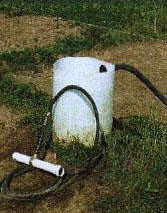Knob Lick Farms Grazing System

Bill Payne, of Stanford, Kentucky, owns and operates Knob Lick Farm. In the past, Bill ran a drylot dairy with his father but now custom raises dairy heifers. After his father retired, Bill decided to disperse the dairy and beef herd. Bill aspired to change to a business which would provide more free-time than the dairy offered.
In 2001, Bill became involved in a network of dairy heifer producers and bought his first set of heifers. He has continued to buy heifers every year since. The heifers arrive at Knob Lick Farm weighing around 400 pounds. They are raised on a high-quality forage diet. The heifers are bred using A.I. once and naturally bred thereafter if needed. They are returned to the dairy seven months pregnant weighing around 1150 pounds.
Bill believes in keeping things simple, reducing the use of machinery, and letting the livestock do the work. The heifers harvest the majority of their feed and spread their own manure. Bill uses management intensive grazing (MIG) to maximize forage utilization and forage production and to minimize the number of days that stored feed is used.
Forages are intensely managed on this farm to maximize forage quality and production which, in turn, maximizes animal performance. In the spring, cool season forages are grazed. First, orchardgrass and tall fescue paddocks are grazed. Bill has renovated these pastures with red clover and ladino clover. Adding legumes benefits soil fertility by fixing nitrogen and provides a more nutritious, higher quality feed.
In May, an alfalfa/orchardgrass mix is cut, rolled, and wrapped to be used as baleage. Bill explains that baleage is easier to produce at times of high precipitation and humidity. Also, in comparison to hay, a larger amount of alfalfa leaves are retained, which means higher quality feed. During the hot months when cool season grasses experience summer slump, the heifers are grazed on alfalfa/orchardgrass mix and at times, summer annuals such as millet and Sudex. Bill prefers not to use annuals because of the yearly seeding cost. In the late summer and early fall, the heifers are taken off any tall fescue fields, which are used for stockpiling for late fall and early winter use. Alfalfa fields are taken out of the grazing rotation at this time to allow the roots to regain nutrient reserves before frost. The cool season forages which are not being used for stockpiling are re-grazed in the fall. In the late fall to early winter, Bill grazes the last of the alfalfa and later grazes the stockpiled tall fescue fields. Bill has grazed standing corn and winter annuals in the past. The baleage is fed until the spring growth is sufficient for grazing. These paddocks are grazed in a rotational or strip grazing technique.
Water and fencing systems are vital to a functional rotational grazing system. When Bill began using this method, he discovered that he would need up to 80 watering points to keep water within 800 feet of all areas on his farm. Because of the high expense, Bill decided to utilize portable water tubs and move them as he moved the heifers.
Since the heifers are grazed year round, Bill needs a watering system that will not freeze. With the help of NRCS and the Lincoln County Extension agriculture agent, Bill designed a portable, freeze-proof water system. Two-inch PVC lines were run underground throughout the farm. Meter boxes were installed at watering points where quick couplers could be attached. They built their own portable tubs that allow a small stream of water to constantly flow, which keeps tubs and water lines from freezing. A ball valve is open during times of freezing temperatures to allow water to flow through a 1/16 inch hole. The water will overflow so excess water is drained away with a 1.5 inch hose. The cost of building these portable water tubs is low in comparison to installing permanent water points around the farm. Cost share money to keep livestock out of a nearby stream was utilized.
Knob Lick Farm raises dairy heifers in a forage based system. Using rotational grazing has allowed Bill to rely minimally on using stored forages. Bill manages his pastures for optimal forage quality, forage production, heifer growth, and herd health.
“...keeping things simple, reducing the use of machinery, and letting the livestock do the work.”
Categories:
General
Farm Highlights


